Treading on hallowed ground: Football Hallelujah! at the Amsterdam Museum
03 April 2015 – Kathy Shinnick
(Editor’s Note: This post is the second in a series on the Amsterdam Museum. To read the first post, click here.)
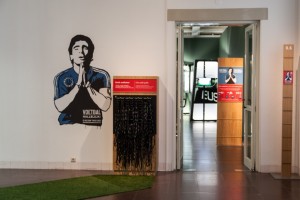
The exhibit’s leading image, Argentina’s legendary Diego Maradona in his classic praying pose, introduced a striking thematic juxtaposition. Photo Credit: Caro Bonink/Amsterdam Museum
“The stadiums are getting fuller and the churches emptier.”
This observation, from Amsterdam Museum director Paul Spies, served as the inspiration for the museum’s intriguing, controversial, and, at times, humorous temporary exhibit Football Hallelujah! On view September 2014 through January 2015, the exhibit explored the ways in which international football (soccer) fandom parallels a religious experience. While attending the first annual conference of the International Federation of Public History I visited the exhibit, intrigued to see the approach taken by a curatorial staff that dared to tread on sports fans’ hallowed ground.
Consistent with the Amsterdam Museum’s mission to “bring history to life for an audience as large and diverse as possible” while also “challenging residents and visitors to deepen their relationship with the city,” Football Hallelujah! invited and encouraged visitors to think critically about the impact of football by exploring issues of adoration, occult-like identity, and religious fervor on both a global and local scale. General comparisons between religion and sports were abundant and striking: a chalice sitting opposite a trophy demonstrated the power of symbolism, a team logo-laden baby outfit and coffin communicated the intersection of sports and identity, and an altar adorned with sports paraphernalia spoke to the prevalence of hero worship. Further, multi-dimensional concepts underscored the complexity of analyzing a seemingly pop culture topic within the framework of historical theory.
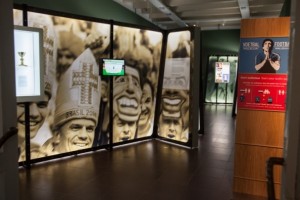
The exhibit contained many examples of religious symbols displayed at football matches. Photo credit: Caro Bonink/Amsterdam Museum
In an effort to explore the complicated comparison of football and religious rivalries, Annemarie de Wildt and her curatorial staff intriguingly utilized six pieces of Floor Wesseling’s controversial art: cut and re-sewn professional football jerseys. Wesseling, an Amsterdam native, designed this art to express his sentiment that “we will all be a mixture soon anyway,” suggesting that crossing sport rivalries and cultural loyalties is acceptable, perhaps inevitable. Fittingly, at least one conjoined jerseys elicited a public outcry amongst Dutch fans after a Feyenoordfan Facebook page posted an image of Wesseling’s Feyenoord/Ajax jersey. More than five hundred angry and threatening comments flooded the post, prompting the museum to hire additional security. While thankfully no trouble occurred, the impassioned reaction underscored the exhibit organizers’ assertion that “Football is passion, football is war, and football is god.”
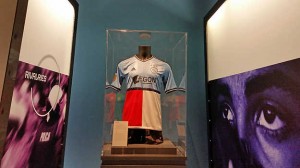
Wesseling’s half Feynoord/half Ajax shirt was kept behind glass as a means of protection. Photo credit: Caro Bonink/Amsterdam Museum
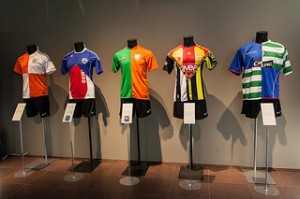
2. Five additional Wesseling pieces were placed in the exhibit, each making their own statement. Photo credit: Caro Bonink/Amsterdam Museum
Overall, most visitors responded positively to the well-balanced content, the result of a strategic collaboration process. This illuminating experience was further passed to the visitor, as evidenced by comments on an interactive web platform. Not surprisingly, visitor feedback also revealed a larger and more diverse visitation during the exhibit’s tenure. In particular, the museum observed an increase in non-traditional museumgoers as well as male visitors, many of whom attended with their children as they do weekly matches. In hopes of reaching an even wider audience, the museum designed the exhibit for international tour in partnership with the Historical Museum of Basel.* To this end, three-quarters of the exhibit explored a worldwide perspective and will remain relatively unchanged, while the final section analyzed football culture in The Netherlands and will be adapted by each museum for their particular version of the exhibit.
Attempting to maintain a neutral voice, the curatorial staff designed the exhibit with limited text. This platform invited visitors to unveil content layers by exploring powerful images and objects. A plethora of multi-sensory elements communicated an emotion-filled message: visitors are greeted by the international football hymn, “You will never walk alone,” images of stadiums filled with hand-raised fans rotated opposite places of religious worship, and expressive videos portrayed the power of superstitious fan rituals. English- and Dutch- translated audio tours supported the concise text panels. However, in the absence of strong analytical text or reflective questions, the interpretation only loosely connected a series of independent sub-themes, such as Saints and Heroes, Rank and Station, and Rituals. While this style provided space for visitors to draw their own conclusions, it also required them to think well beyond the text and rely on a certain base of religious and football knowledge.
The interpretive style worked for basic concepts, but subjects of deeper context would have been more comprehensible with further explanation. For example, a short description of Feynoord fans’ use of anti-Semitic slurs lacked sufficient historic context to enable visitors to parse the complex relationship between Europe’s anti-Semitic history, the role of The Netherlands during the Holocaust, and contemporary football fans’ adoption of traditional scapegoats as proxies for their rivalries. Apparently, this fan behavior is well known throughout Europe, which may explain the lack of further exploration in the exhibit text. However, additional context would have supported the overall interpretation as, perhaps, nothing reinforced the exhibit’s comparative theme more than the allusion to a blind faith that somehow permits the trivialization of the Holocaust in the name of fandom.
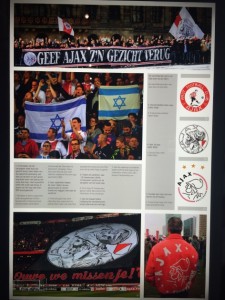
Images also communicated how Ajax fans have adopted Israeli symbols and colors. Photo credit: Kathy Shinnick
Upon their exit, visitors were asked to answer just one overarching reflective question: “Do you consider football a religion?” Interestingly, the answers were fairly even on both sides. However, in the absence of additional questions, it is difficult to understand the reasons for this response. In this way, the curators missed a profound opportunity to engage the visitor with at least a series of open-ended questions to facilitate reflection beyond the given text and, at most, more in-depth descriptions surrounding complex comparisons.
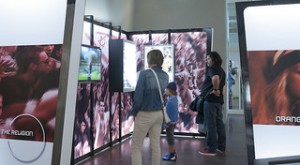
Visitors of all ages engaged in the multi-sensory experience. Photo Credit: Caro Bonink/Amsterdam Museum
Despite a lack of interpretive conclusions, the Amsterdam Museum is to be commended for taking an important step. By simply drawing the comparisons, they illuminated sport’s cultural relevance and complexities that go beyond the expected hero worship and trophy display usually found in sports exhibits. Personally, I also gained new perspectives on the topic and left contemplating why I rarely find exhibits willing to interpret universal themes of humanity within the context of sports. Granted, while the popularity of sports contributes to the fatuous nature of some sport history, historians are currently trailblazing scholarship pertaining to its cultural impact. This is a great opportunity for museums, especially since the public trusts public historians to get it right. To professionals interpreting history for a sports-centric community, I offer this charge: If we build it, they will come. Surely, the Amsterdam Museum has proven this. However, they have also given us room to explore the most relevant ways to connect with this disparate population of sports fans. Perhaps it is most encouraging to realize that when it comes to interpreting sports for the public, we have only just begun.
*Tour Schedule: Basel 12 March – 16 August 2015 (http://hart.amsterdammuseum.nl/96936/nl/kalbswurst-in-basel), Bremen 16 October 2015 – mid-March 2016, Lyon mid-April – 6 September 2016, Luxembourg 6 October 2016 – 12 March 2017, Barcelona 2017, Moscow 2018 for the FIFA World Cup
~ Kathy Shinnick is an independent public historian. Her work focuses on exhibit curation, museum education, and historical research and writing with a specialty in sites of commemoration, including war, politics, and sports. Her blog, Playing For Keeps explores the intersection of sports and public history.




1 comment